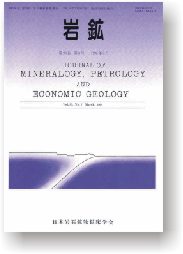巻号一覧

92 巻, 8 号
August
選択された号の論文の3件中1~3を表示しています
- |<
- <
- 1
- >
- >|
論説
-
西岡 芳晴1997 年 92 巻 8 号 p. 291-301
発行日: 1997年
公開日: 2006/09/22
ジャーナル フリーGeological and petrological studies were carried out on the Miyako Granitic Body, a zoned pluton in the North Kitakami Mountains, Northeast Japan. Five different rock types are distinguished based on the modes of occurrence and megascopic character. A large part of this pluton is occupied by Miyako and Yamada rock types. The Miyako rock type is present in the northern portion of the pluton, and consists of quartz diorite and granodiorite with hornblende and biotite. The Yamada rock type is located in the southern part, and consists of granitoids similar to the Miyako rock type, but relatively more coarse-grained and leucocratic. The Ashibatai, Osawa and Shimotanabe rock types crop out in only a few places. The Ashibatai rock type consists of porphyritic monzogranite and is located near the center of the Miyako rock type. The Shimotanabe rock type is located of east of the Yamada type, while the Osawa rock type is even further to the east. Both the Shimotanabe and Osawa rock types are fine-grained and more melanocratic than the Yamada rock type.
Differences between the Miyako and Yamada rock types are apparent in the modal analysis and major and trace elements. Modal and chemical trends of the Osawa rock type are similar to those of the Miyako rock type. The trends for the Shimotanabe and Osawa rock types are, as well as field observations, in general agreement with those displayed by the Yamada rock type. Thus, two distinct magmas are assumed to have been active at the same time in the Miyako Pluton.抄録全体を表示PDF形式でダウンロード (1283K) -
今岡 照喜, 西村 祐二郎, 後藤 芳彦, 中島 和夫, 齋藤 和男, 板谷 徹丸1997 年 92 巻 8 号 p. 302-315
発行日: 1997年
公開日: 2006/09/22
ジャーナル フリーIn the Susa area, western San-in district, Southwest Japan, marine sedimentary rocks (Susa Group), volcanic rocks (Yamashima) and gabbros (Koyama) of Teritary age occur in close relation. The former two rocks have partly undergone contact metamorphism by the Koyama gabbro complex. The Yamashima volcanic rocks, presumed to lie on the Susa Group, consist mainly of submarine massive lavas, hyaloclastites, pseudopillow and feeder dykes of basaltic andesites and their reworked deposits. The Koyama gabbro complex is mainly composed of olivine gabbro, quartz gabbro and quartz diorite. The representative specimens from the Yamashima volcanic rocks and related rocks were dated with the K-Ar method. The groundmass separates from Yamashima volcanic rocks give ages of 13.4 and 14.2 Ma, while biotite from the Koyama gabbro gives an age of 14.1 Ma. The pelitic hornfels of the Susa Group is dated to be 14.8 Ma for biotite, and a porphyrite dyke to be 12.1 Ma for groundmass. The age of the Maeubuyu quartz diorite, 50 km northeast of the Koyama gabbro complex, is 13.7 Ma for the whole rock.
On the basis of newly obtained and reported geochronological and geochemical data and field evidence of igneous rocks in the Susa area, it is argued that the Yamashima-Koyama igneous rocks are a submarine volcano-plutonic complex produced in relation to the opening of Japan Sea in the Middle Miocene.抄録全体を表示PDF形式でダウンロード (3715K) -
亀井 淳志, 大和田 正明, 小山内 康人, 濱本 拓志, 加々美 寛雄1997 年 92 巻 8 号 p. 316-326
発行日: 1997年
公開日: 2006/09/22
ジャーナル フリーHigo plutonic rocks as a part of the Higo metamorphic terrane occur in the central part of Kyushu island, southwest Japan. They are divided mainly into two types, the Miyanohara tonalite and the Shiraishino granodiorite. The Shiraishino granodiorite intrudes into both of the Miyanohara tonalite and the Higo metamorphic rocks. The inclination line for the nine samples from the Miyanohara tonalite gives an age of 121±65 Ma and is not defined as solidification age of this tonalite because of a large error. A Rb-Sr whole rock isochron for the Shiraishino granodiorite indicates an age of 121±14 Ma with an initial ratio of 0.704929±0.000070 (2σ). This whole rock isochron age is regarded as the solidification age for the Shiraishino granodiorite. A Rb-Sr mineral isochron is formed by whole-rock, hornblende, K-feldspar and plagioclase from one rock sample for the Shiraishino granodiorite. This mineral isochron age indicates an age of 100.0±1.7 Ma, and is regarded as the cooling age for the Shiraishino granodiorite. The Rb-Sr whole rock age and Sr initial ratio for the Shiraishino granodiorite are within the range of those of the Cretaceous granitic rocks that occur in the central Kyushu island. Since the timing of peak metamorphism of the Higo metamorphic rocks is believed to be c. 260-240 Ma from their geochronological view points, the magmatism for the Shiraishino granodiorite would not relate with the metamorphism of the Higo metamorphic rocks.抄録全体を表示PDF形式でダウンロード (1767K)
- |<
- <
- 1
- >
- >|